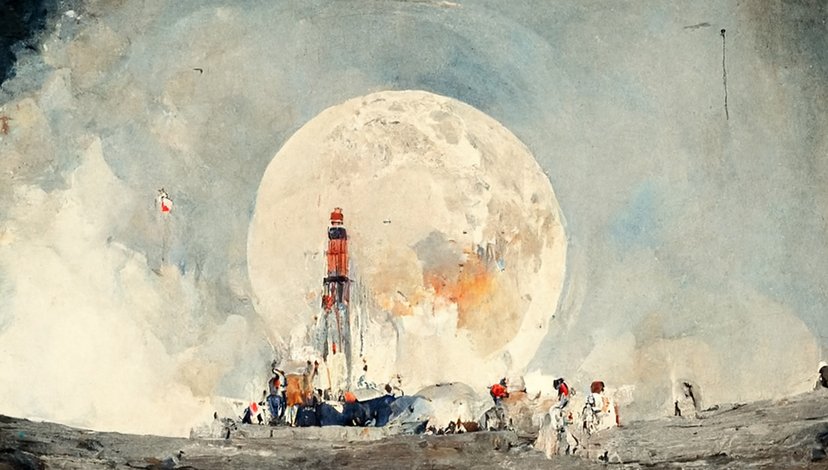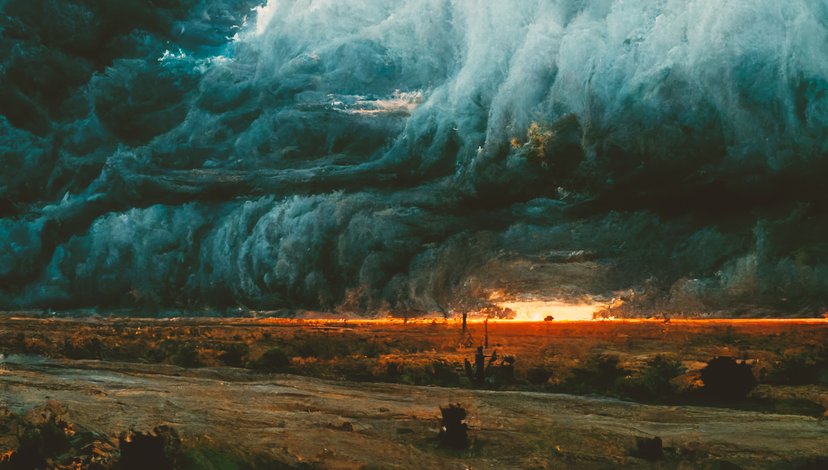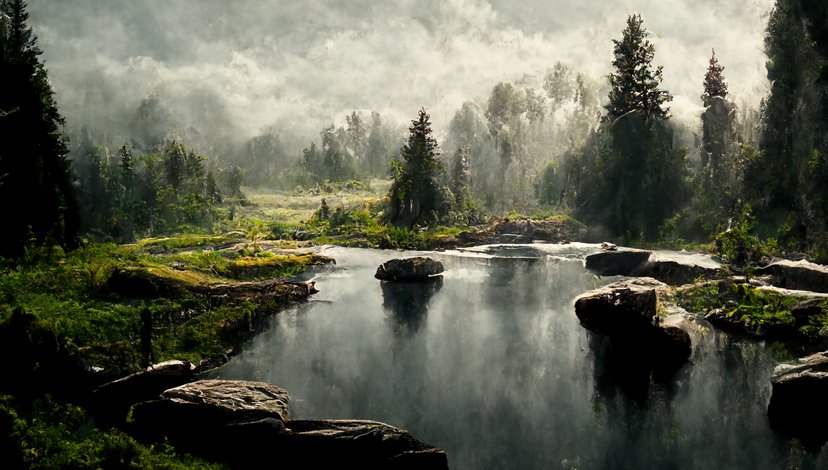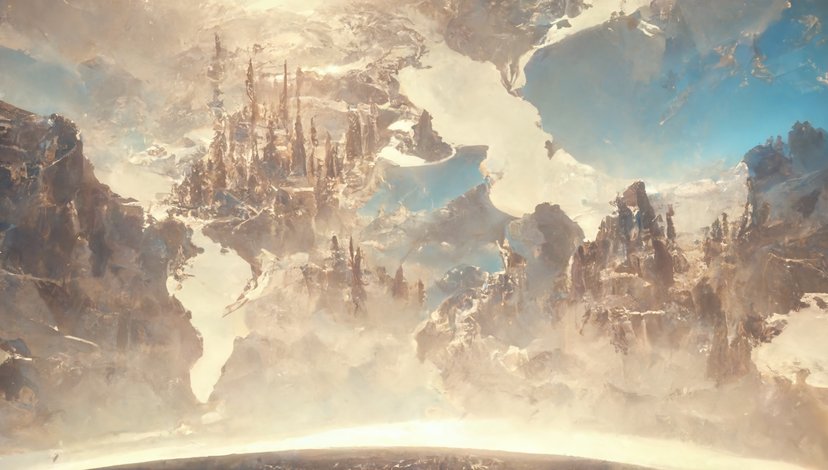ADS4: Green Room
Tutors: Tom Greenall, Matteo Mastrandrea & Nicola Koller

"The Moon landing as if painted by JMW Turner” (Midjourney)
In response to decades of useless logorrhea, political indifference and hostility, and the climate crisis, this year ADS4 sets out to develop a performative architecture, which borrows from theatre’s understanding of the primacy of language on our perception of both time and landscape. We will interrogate the technologies that – through the influence of feudalism, colonialism and capitalism – have historically corrupted representations of landscape. Instead, we will utilise emerging technologies that are likely to determine our future place within it. ADS4 believes we must rewild our language before we can rewild the world.

/imagine: “Landscape at the End of time” (Midjourney)
Act I – The End
When witnessing a catastrophe, whether natural or human-induced, you often hear people declare “The end of the world is near.” Beyond the wide-scale apathy towards the consequences of our actions on the environment, together with our ever–diminishing prospects for an equitable and sustainable existence on this planet, such prophecies expose the more sinister face of our humanity – the desire for sheer destruction.
From a fatalistic perspective, we could revert to Jean Baudrillard’s assertion that human beings’ destructive tendencies stem from a desire to witness the end of times, given we were not present at the beginning. But where does this leave us and what can be done? In architecture, we have surely reached the end of the formal project. Discussions about style and tectonics have been usurped by debates around embodied versus operational carbon, highlighting the need to consider the environmental performance and impact of buildings. Together with the need to understand architecture as a process, rather than a product.
By prioritising the performative aspects of building, might we challenge our blinkered perception of temporality and duration in architecture? To address this question we must first linguistically destabilise our usual experience of time. In 2022–23, ADS4 will structure our teaching in reverse. This year we start at THE END.

/imagine: “Landscape Theatre, HD, photorealistic” (Midjourney)
Act II – Landscape Theatre
In our pursuit of a performative architecture that might address our inability to think about time in more complex ways, we will look to theatre as both a linguistic practice and spatial typology, which reframes time as a critical component of experience.
To understand theatrical time, we must understand the origin of theatrical space – at least in the Western tradition – as the garden. During the sixteenth and seventeenth centuries, gardens became the primary sites of performance. Existing before theatres with prosceniums dominated, gardens and pastoral settings were a favourite setting for masques and operas, with gardens taking the form of amphitheatres and exedras. The best scenographers were historically landscape designers and the exchange between landscape and theatre was vital and inventive. Yet while the study of landscape as the beginnings of the formalism of modern theatre is well documented, the consequences and implications for the landscape itself are largely ignored.
The interconnected development of landscape design and scenography goes some way in explaining our susceptibility to value land predominantly for its scenic and picturesque qualities. This year, ADS4 will seek to interrogate the biases in Western thought which consistently privilege form over process. And, as such, fail to recognise the significance of temporality in more equitable conceptualisations of land and landscape.
Any investigation into the performative aspects of architecture must start with land. By positioning landscape as performance, can we hope to provide a design methodology that helps us maintain a safe distance from The End?

/imagine: “A building designed by the students of ADS4, Royal College of Art, photographed in the style of Gregory Crewdson” (Midjourney)
Act III – Land before Landscape
The English term ‘landscape’ actually comes from a term of Dutch origin landschap, which referred to a static painterly view of typically rural surroundings. This means that the concept of landscape, if used unproblematically and uncritically, carries with it a range of culturally specific assumptions. That it is a visual phenomenon. That it has aesthetic value, embodying a pleasing or ‘picturesque’ form. And that the rural is a form of ‘nature’. But before landscape painting, there was only land, free from these sorts of associations.
The representation, characterisation and understanding of land has been dominated by this etymological baggage for too long. Renaissance landscape painting helped create a territorial relationship to the land that is intimately tied up with the history of European capitalism and imperialism. While the violence Western cartographic conventions have inflicted are widely recognised, the role of landscape painting as a form of ‘soft’ cartography that stakes similar claims over land/territory – and nature – is less widely appreciated. Therefore, liberating land from landscape is an inherently critical task.

/imagine: “Future world map” (Midjourney)
Act IV – Technology and the Representation of Land
To a certain extent, all landscape images play into fantasy, highlighting the rift between lived and perceived space. While Renaissance perspective provided the means to represent ownership over the land for the privileged who could afford to commission such works, the invention of celluloid film in the nineteenth century would eventually birth landscape photography and, with it, the mass consumption of landscape imagery. Erasing time, topography and narrative, landscape photography popularised a view of space as static and unmarred. A view that disguises the realities of environmental depredation, economic enclosure and political contestation.
From Edmund Burke’s notion of the sublime, to the subtle atmospheric backgrounds set as defaults on our screens, the understanding of nature as separate from human life permeates visual culture. It is so deeply entrenched that landscape images almost always perpetuate a destructive duplicity – using fantasy to avert attention away from environmental realities, or framing them with such an aestheticization they can only overwhelm our visual senses.
Computer graphics have now conquered the uncanny valley – that strange place where things are almost real, but not quite, not yet. Simulation algorithms within animation software mean that each leaf on a virtual tree moves individually in response to a simulated gust of wind, resulting in moving images that are almost indistinguishable from reality.And the ability to render these scenes in real-time allows an appreciation of temporality and an ability to dwell in the virtual landscape that only theatre previously suggested.
With the battle for photorealistic CGI now won, the question is what landscapes will we find on the other side of this uncanny valley?
Act V – The Beginning: Rewilding Language
Over the past six months, a number of text-to-image AI tools have emerged – including DALL-E, Midjourney and Stable Diffusion – that have grown in popularity and complexity. By writing simple text prompts, users of these tools can create digital images and artworks with little to no understanding of the underlying technologies. Yet, as anyone who has used them quickly finds out, some prompts are better than others. Some words are more effective, more resonant, more unexpected, with their syntax playing a role. This has led to an emerging field of linguistic design – a practice called “prompt engineering”, “prompt programming”, or “prompting”).
The primacy these tools give to language in the production of images is fertile territory. In the terms we have set, this also makes them theatrical. Like theatre design, which starts with a script, these AI tools use words to dictate form. Vocabulary engendering landscape. This year, ADS4 will use these tools to better understand how rewilding our words might unlock new forms of landscape. Ones that have the potential to be more equitable and sustainable than the capitalist landscape of today.
We will explore the ‘what if’ of architectural design being mediated through the design of prompts? How can these text–to–image tools pave the way for a second linguistic turn in architecture? A turn that utilises the logic and potential of prompt design to unlock new attitudes towards land, the built environment, and the planet? This year, ADS4 will attempt to make sense of these tools to better understand the role language might play in determining the temporal landscape of our futures.

/imagine: “Contemporary London as if painted by Canaletto” (Midjourney)
Prelude – Live Project
- This year, ADS4 will work with the East London Waterworks Park – a community-led organisation putting forward proposals to acquire and transform the 5.68-hectare ex-Thames Water Depot on Lea Bridge Road in Waltham Forest. This site will be transformed into a biodiversity habitat and natural swimming pool.
- The Whitechapel Gallery has invited ADS4 to host an event at the gallery about narrative, speculation and ‘un-worldbuilding’.